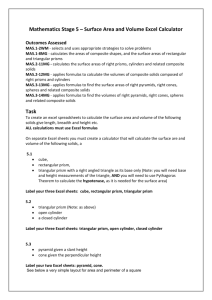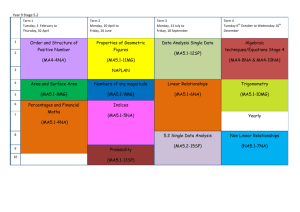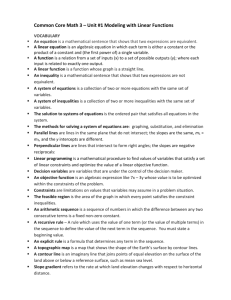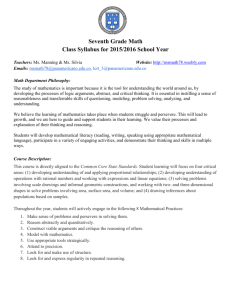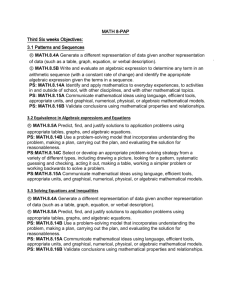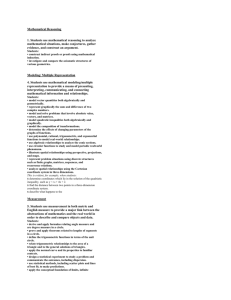Mathematics ~ Stage 5 Course Outlines
advertisement
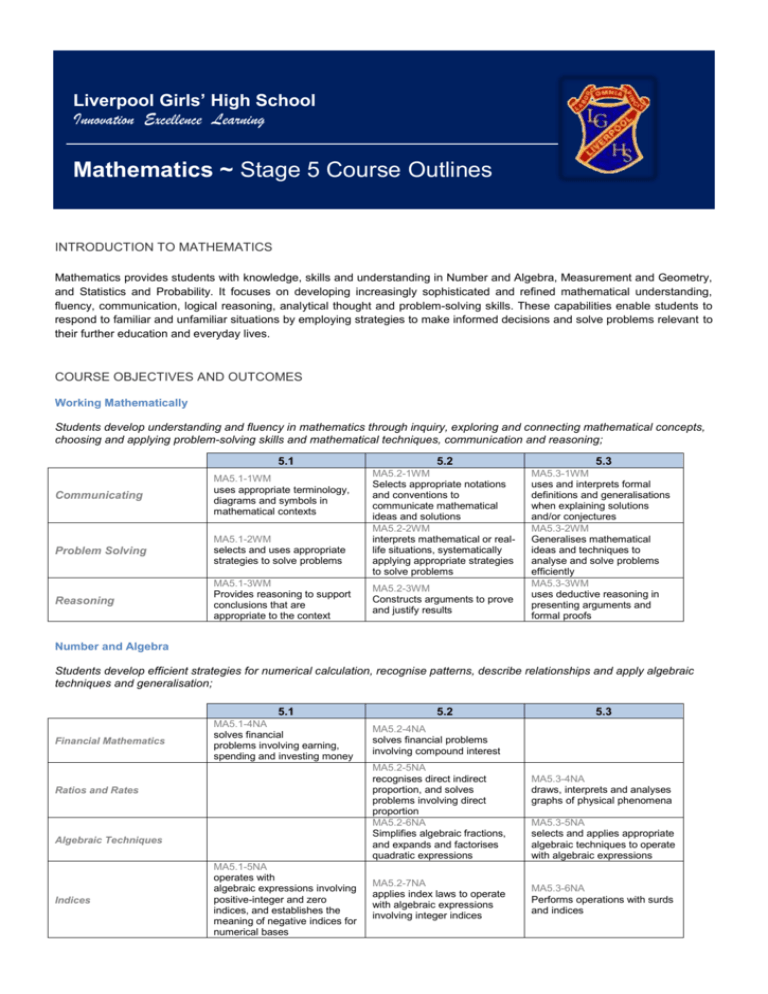
Liverpool Girls’ High School Innovation Excellence Learning Mathematics ~ Stage 5 Course Outlines INTRODUCTION TO MATHEMATICS Mathematics provides students with knowledge, skills and understanding in Number and Algebra, Measurement and Geometry, and Statistics and Probability. It focuses on developing increasingly sophisticated and refined mathematical understanding, fluency, communication, logical reasoning, analytical thought and problem-solving skills. These capabilities enable students to respond to familiar and unfamiliar situations by employing strategies to make informed decisions and solve problems relevant to their further education and everyday lives. COURSE OBJECTIVES AND OUTCOMES Working Mathematically Students develop understanding and fluency in mathematics through inquiry, exploring and connecting mathematical concepts, choosing and applying problem-solving skills and mathematical techniques, communication and reasoning; 5.1 Communicating MA5.1-1WM uses appropriate terminology, diagrams and symbols in mathematical contexts Problem Solving MA5.1-2WM selects and uses appropriate strategies to solve problems Reasoning MA5.1-3WM Provides reasoning to support conclusions that are appropriate to the context 5.2 5.3 MA5.2-1WM Selects appropriate notations and conventions to communicate mathematical ideas and solutions MA5.2-2WM interprets mathematical or reallife situations, systematically applying appropriate strategies to solve problems MA5.3-1WM uses and interprets formal definitions and generalisations when explaining solutions and/or conjectures MA5.3-2WM Generalises mathematical ideas and techniques to analyse and solve problems efficiently MA5.3-3WM uses deductive reasoning in presenting arguments and formal proofs MA5.2-3WM Constructs arguments to prove and justify results Number and Algebra Students develop efficient strategies for numerical calculation, recognise patterns, describe relationships and apply algebraic techniques and generalisation; 5.1 Financial Mathematics MA5.1-4NA solves financial problems involving earning, spending and investing money Algebraic Techniques MA5.1-5NA operates with algebraic expressions involving positive-integer and zero indices, and establishes the meaning of negative indices for numerical bases 5.3 MA5.2-4NA solves financial problems involving compound interest MA5.2-5NA recognises direct indirect proportion, and solves problems involving direct proportion MA5.2-6NA Simplifies algebraic fractions, and expands and factorises quadratic expressions Ratios and Rates Indices 5.2 MA5.2-7NA applies index laws to operate with algebraic expressions involving integer indices MA5.3-4NA draws, interprets and analyses graphs of physical phenomena MA5.3-5NA selects and applies appropriate algebraic techniques to operate with algebraic expressions MA5.3-6NA Performs operations with surds and indices 5.1 5.2 5.3 MA5.2-8NA solves linear and simple quadratic equations, linear inequalities and linear simultaneous equations, using analytical and graphical techniques MA5.3-7NA solves complex linear, quadratic, simple cubic and simultaneous equations, and rearranges literal equations Linear Relationships MA5.1-6NA determines the midpoint, gradient and length of an interval, and graphs linear relationships MA5.2-9NA uses the gradient-intercept form t interpret and graph linear relationships MA5.3-8NA uses formulas to find midpoint, gradient and distance on the Cartesian plane, and applies standard orms of the equation of a straight line Non-Linear Relationships MA5.1-7NA graphs simplenon-linear relationships MA5.2-10NA Connects algebraic and graphical representations of simple non-linear relationships MA5.3-9NA sketches and interprets a variety of nonlinear relationships Equation MA5.3-10NA recognises, describes and sketches polynomials, and applies the factor and remainder theorems to solve problems MA5.3-11NA uses the definition of a logarithm to establish and apply the lawsof logarithms MA5.3-12NA uses function notation to describe and sketch functions Polynomials Logarithms # Functions and Other Graphs # Measurement and Geometry Students identify, visualise and quantify measures and the attributes of shapes and objects, and explore measurement concepts and geometric relationships, applying formulas, strategies and geometric reasoning in the solution of problems 5.1 Area and Surface Area MA5.1-8MG calculates the areas of composite shapes, and the surface areas of rectangular and triangular prisms 5.2 MA5.2-11MG calculates the surface areas of right prisms, cylinders and related composite solids MA5.2-12MG applies formulas to calculate the volumes of composite solids composed of right prisms and cylinders Volume Numbers of Any Magnitude MA5.1-9MG interprets very small and very large units of measurement, uses scientific notation, and rounds to significant figures Right-Angled Triangles (Trigonometry) MA5.1-10MG applies trigonometry, given diagrams, to solve problems, including problems involving angles of elevation and depression MA5.2-13MG Applies trigonometry to solve problems, including problems involving bearings Properties of Geometrical Figures MA5.1-11MG describes and applies the properties of similar figures and scale drawings MA5.2-14MG calculates the angle sum of any polygon and uses minimum conditions to prove triangles are congruent or similar Circle Geometry # 5.3 MA5.3-13MG Applies formulas to find the surface areas of right pyramids, right cones, spheres and related composite solids MA5.3-14MG applies formulas to find the volumes of right pyramids, right cones, spheres and related composite solids Trigonometry and Pythagoras' Theorem MA5.3-15MG Applies Pythagoras’ theorem, trigonometric relationships ,the sine rule, the cosine rule and the area rule to solve problems, including problems involving three dimensions MA5.3-16MG proves triangles are similar, and uses formal geometric reasoning to establish properties of triangles and quadrilaterals MA5.3-17MG Applies deductive reasoning to prove circle theorems and to 5.1 5.2 5.3 solve related problems Statistics and Probability Students collect, represent, analyse, interpret and evaluate data, assign and use probabilities, and make sound judgements; 5.1 Single Variable Data Analysi MA5.1-12SP uses statistical displays to compare sets of data, and evaluates statistical claims made in the media Bivariate Data Analysis Probability MA5.1-13SP Calculates relative frequencies to estimate probabilities of simple and compound events 5.2 5.3 MA5.2-15SP uses quartiles and box plots to compare sets of data, and evaluates sources of data MA5.3-18SP uses standard deviation to analyse data MA5.2-16SP Investigates relationships between two statistical variables, including their relationship over time MA5.3-19SP investigates the relationship between numerical variables using lines of best fit, and explores how data is used to inform decision-making processes MA5.2-17SP describes and calculates probabilities in multi-step chance experiments Stage 5 Mathematics (5.1/5.2/5.3) Year 9- SEMESTER ONE PYTHAGORAS THEOREM AND SURDS* MA4-16MG MA5.1-1WM MA5.1-2WM MA5.3-6NA Pair share activities. Matching Pythagoras' theorem to diagrams and open-ended questions Problem solving using Task Centres WORKING WITH NUMBERS MA5.1-1WM MA5.1-4NA MA5.2-1WM MA5.2-2WM MA4-18MG ALGEBRA, PRODUCTS FACTORS* MA5.2-1,3WM MA5.2-6NA MA5.3-1WM MA5.3-5NA TRIGONOMETRY MA5.1-1,2,3 WM MA5.1-10 MG MA5.2-1,2WM MA5.2-13-MG INDICES MA5.1-1,3WM w MA5.1-5NA Students demonstrate their ability to: apply Pythagoras' theorem to calculate side lengths in rightangled triangles and solve related problems perform operations with surds and indices solve financial problems involving earning, spending and investing money interpret mathematical or reallife situations, systematically applying appropriate strategies to solve problems apply appropriate algebraic techniques to operate with algebraic expressions apply trigonometry to solve problems, including problems involving bearings apply index laws to operate with algebraic expressions involving integer indices calculate the angle sum of any polygon constructs arguments to prove and justify results MA5.1—9MG MA5.2-7NA MA5.3-1WM * MA5.3-6NA GEOMETRY Group work. Solving practical problems involving trigonometry and bearings Written class task Assignment: research the names of the big numbers or metric prefixes * = Stage 5.3 Content MA5.2-1,3WM MA5.2-14MG Construction activity: triangles, quadrilaterals and polygons Stage 5 Mathematics (5.1/5.2/5.3) Year 9 - SEMESTER TWO EQUATIONS MA5.2-1WM MA5.2-2WM MA5.2-8NA MA5.3-7NA * Pair share activities. Comparing and evaluating the different methods of solving an equation EARNING MONEY Assignment: Case study on the different ways of earning money MA5.1-1WM MA5.1-2WM MA5.1-3WM MA5.1-4NA INVESTIGATING DATA MA5.1-1,3WM MA5.1-2WM MA5.1-3WM MA5.1-12SP MA5.2-3WM SURFACE AREA AND VOLUME MA5.1-1,2, WM MA5.1-8,9 MG MA5.2-1,2WM MA5.2-11MG MA5.2-12MG MA5.3-14MG * COORDINATE GEOMETRY AND GRAPHS MA5.1-1,3WM MA5.1-6NA MA5.2-1,2,3WM w MA5.2-5,9,10NA MA5.3-2WM* MA5.3-8NA* Students demonstrate their ability to: solve linear and simple quadratic equations, linear inequalities and linear simultaneous equations, using analytical and graphical techniques solve financial problems involving earning, spending and investing money use statistical displays to compare sets of data, and constructs arguments to prove and justify results calculate the surface area of right prisms, cylinders and related composite figures apply formulas to calculate the volume of composite solids composed of right prisms and cylinders determine the midpoint, gradient and length of an interval, and graphs linear relationships describe and calculate probabilities in multi-step chance experiments MA5.3-1WM MA5.3-6NA Group work. Investigate the use and abuse of statistics and statistical graphs in the media Written class task Practical activity. Surface area and volume of various solids PROBABILITY MA5.1-1,2,3WM MA5.1-13SP MA5.2-1WM MA5.2-2WM MA5.2-3WM MA5.2-17SP * = Stage 5.3 content Construction activity: triangles, quadrilaterals and polygons Stage 5 Mathematics (5.1/5.2/5.3) Year 10 - SEMESTER ONE INTEREST AND DEPRECIATION MA5.1-1,2,3WM MA5.1-4NA MA5.2-1WM MA5.2-2WM Investigation activity, comparing different interest rates, principals or compounding periods ALGEBRA MA5.1 – 1, 3 WM MA 5.1 – 5 NA MA 5.2 – 1, 3 WM MA 5.2 – 6 NA MA 5.2 – 7 NA COORDINATE GEOMETRY MA5.1-1,3WM MA5.1-6NA MA5.2-1WM MA5.2-3WM MA5.2-9NA SURFACE ALGEBRA AREA MA5.1-1,3WM VOLUME MA5.1-5NA MA5.1-1,2WM MA5.2-1WM MA5.1-8MG MA5.2-3WM MA5.2-1,2WM MA5.2-6,7NA MA5.2-11MG MA5.2-12MG DATA MA5.1-12SP MA5.2-1WM MA5.2-3WM MA5.2-15SP w MA5.2-16SP Practical graphing task Students demonstrate their ability to: solve financial problems involving earning, spending, investing money and compound interest use the gradient-intercept form to intercept and graph linear relationships calculate the areas of composite shapes, and the surface areas of rectangular and triangular prisms, cylinders and composite solids apply formula to calculate volumes of composite solids, right prisms and cylinders simplify algebraic fractions, expand and factorise quadratic expressions use quartiles and box plots to compare sets of data solve linear and simple quadratic equations, linear inequalities, simultaneous equations recognise and solve direct proportion problems Group activity. Open-ended and back-to-front problems given surface area and volume Written class task Research the role of the Australian Bureau of Statistics EQUATIONS MA5.2-1WM MA5.2-2WM MA5.2-3WM MA5.2-8NA * = Stage 5.3 Content GRAPHS MA5.1-1WM MA5.1-3WM MA5.1-7NA MA5.2-1,3WM MA5.2-5NA MA5.2-10NA Matching activity, equations to their graphs Stage 5 Mathematics (5.1/5.2/5.3) Year 10 - SEMESTER TWO TRIGONOMETRY MA5.1-1,2,3WM MA5.1-10MG MA5.2-1WM MA5.2-2WM MA5.2-13 Group work. Solving problems involving angles of elevation and depression Writing activity comparing and evaluating the different methods of solving simultaneous equations Simultaneous Equations MA5.2-1WM MA5.2-2WM MA5.2-8NA PROBABILITY MA5.1-1,2,3WM MA5.1-13SP MA5.2-1WM MA5.2-2WM MA5.2-3WM MA5.2-17SP GEOMETRY MA5.1-1,2,3WM MA5.1-11MG MA5.2-1WM MA5.2-2WM MA5.2-3WM MA5.2-14MG PRODUCTS AND FACTORS* Students demonstrates ability to: apply trigonometry to solve problems, including problems involving bearings solve linear and simple quadratic equations, linear inequalities and linear simultaneous equations describe and calculate probabilities in multi-step chance experiments calculate angle sum of any polygon, proofs of similar and congruent triangles select and apply appropriate algebraic techniques to operate with algebraic expressions apply appropriate mathematical techniques to solve problems Practical activity. Experimental probability investigation Written class task MA5.3-1WM MA5.3-5NA MA5.3-1WM MA5.3-6NA Problem solving, using algebra and equations w SURDS* MA5.3-1WM MA5.3-2WM MA5.3NA Quadratic Equations and the Parabola* MA5.3-1/2WM MA5.3-2WM MA5.3-7NA MA5.3-9NA Assignment. Proving properties of geometrical figures by congruent triangles * = Stage 5.3 Content Mathematics ~ Performance Descriptors Areas for Assessment Knowledge, skills and understanding Students: Working Mathematically – develop understanding and fluency in mathematics through inquiry, exploring and connecting mathematical concepts, choosing and applying problem-solving skills and mathematical techniques, communication and reasoning Number and Algebra – develop efficient strategies for numerical calculation, recognise patterns, describe relationships and apply algebraic techniques and generalisation Measurement and Geometry – identify, visualise and quantify measures and the attributes of shapes and objects, and explore measurement concepts and geometric relationships, applying formulas, strategies and geometric reasoning in the solution of problems Statistics and Probability – collect, represent, analyse, interpret and evaluate data, assign and use probabilities, and make sound judgements. Grade A10 A student performing at this grade uses and interprets formal definitions and generalisations when explaining solutions; generalises mathematical ideas and techniques and selects and uses efficient strategies consistently and accurately to solve unfamiliar multi-step problems; uses deductive reasoning in presenting clear and concise mathematical arguments and formal proofs; synthesises mathematical techniques, results and ideas across the course. A student at this grade typically: uses graphical techniques and a variety of analytical methods to solve problems involving quadratic equations and simultaneous equations; manipulates algebraic expressions and equations with consideration given to restrictions on the values of variables solves problems involving surface area and volume of right pyramids, right cones, spheres, and related composite solids, and applies similarity relationships for area and volume; applies deductive reasoning to prove properties of isosceles and equilateral triangles, and special quadrilaterals uses and interprets the mean and standard deviation to make comparisons between data sets; critically evaluates the processes of planning, collecting, analysing and reporting studies in the media and elsewhere. Grade A9 A student performing at this grade uses formal definitions and generalisations when explaining solutions; generalises mathematical ideas and techniques and selects and uses efficient strategies to solve unfamiliar multistep problems; uses deductive reasoning in presenting mathematical arguments and formal proofs. A student at this grade typically: performs operations with surds and indices in numerical and algebraic contexts; analyses and describes graphs of physical phenomena; uses analytical methods to solve complex linear, quadratic, simple cubic, and simultaneous equations, including simultaneous equations where one equation is non-linear uses trigonometry to solve practical problems involving non-right-angled triangles; constructs geometrical arguments and formal proofs of geometrical relationships uses the mean and standard deviation to make comparisons between data sets; evaluates the use of data to inform decision-making processes. Grade B8 A student performing at this grade uses formal definitions when explaining solutions; selects and uses efficient strategies to solve familiar and some unfamiliar multi-step problems; uses some deductive reasoning in presenting mathematical arguments; may require some guidance to determine the most efficient methods. A student at this grade typically: applies special products to expand binomial products and factorises a variety of quadratic expressions; draws and interprets a variety of graphs, and applies coordinate geometry techniques to solve problems calculates the surface area and volume of right pyramids, right cones, spheres, and related composite solids; constructs geometrical arguments to prove a general geometrical result, giving reasons calculates and uses standard deviation to analyse data; interprets the relationship between numerical variables using lines of best fit. Grade B7 A student performing at this grade selects and uses appropriate mathematical language, notations and conventions to communicate mathematical ideas and solutions; systematically applies appropriate strategies to solve familiar multi-step problems; constructs appropriate mathematical arguments to prove and justify results; often requires guidance to determine the most efficient methods. A student at this grade typically: applies the compound interest formula to solve financial mathematics problems, including those involving depreciation; solves simultaneous linear equations using an algebraic or graphical method; draws and interprets graphs of simple parabolas, circles and exponentials calculates the surface area and volume of simple composite solids; solves trigonometry problems involving bearings, angles of elevation and depression, and angles measured in degrees and minutes determines and uses quartiles and the interquartile range to compare sets of data; evaluates sources of data in media reports and elsewhere; evaluates conditional statements in chance situations. Grade C6 A student performing at this grade uses appropriate mathematical language, notations and diagrams to communicate mathematical ideas and solutions; applies appropriate strategies to solve familiar multi-step problems; constructs some appropriate mathematical arguments to obtain and justify results. A student at this grade typically: expands and factorises simple algebraic expressions and simplifies algebraic expressions involving fractions and positive, negative and zero indices; solves simple quadratic equations uses formulae to calculate the surface area and volume of right prisms and cylinders; uses simple deductive reasoning in solving numerical problems in different geometrical contexts, and applies tests for proving that triangles are congruent determines the quartiles and interquartile range for a set of data; constructs and interprets displays of bivariate numerical data; calculates probabilities and interprets the results for multi-step chance experiments. Grade C5 A student performing at this grade uses mathematical language, notations and diagrams to communicate mathematical ideas; applies appropriate strategies, often with the assistance of given diagrams and formulae, to solve simple familiar problems; constructs some mathematical arguments to obtain results. A student at this grade typically: uses conversion graphs to convert from one unit to another and given graphs to solve simple linear simultaneous equations; finds and graphs the equations of straight lines given the gradient and y-intercept solves simple word problems in trigonometry; applies results related to the angle sum for polygons to solve simple numerical problems identifies simple relationships between two statistical variables; calculates probabilities for multi-step chance experiments. Grade D4 A student performing at this grade uses appropriate mathematical terminology, diagrams and symbols in mathematical contexts; selects and uses appropriate standard strategies to solve simple familiar problems; provides some reasoning to support conclusions that are appropriate to the context. A student at this grade typically: graphs simple linear and non-linear relationships by constructing a table of values; uses diagrams to solve simple coordinate geometry problems finds the area of simple composite figures; given diagrams, uses trigonometry to find sides and angles in right-angled triangles interprets back-to-back stem-and-leaf plots, and statistical claims made in the media; calculates relative frequencies to estimate probabilities of simple and compound events. Grade D3 A student performing at this grade uses mathematical terminology, diagrams and symbols in mathematical contexts; uses appropriate standard strategies to solve simple familiar problems; provides some reasoning to support conclusions. A student at this grade typically: solves simple financial mathematics problems involving earning and spending money and, given the formula, calculates simple interest; completes a table of values to graph simple linear relationships expresses trigonometric ratios for angles in right-angled triangles in terms of an unknown side; uses the scale factor to find unknown sides in similar triangles calculates the mean, median and range to compare two sets of numerical data; uses data from Venn diagrams and two-way tables to calculate simple probabilities. Grade E2 A student performing at this grade uses some mathematical terminology in mathematical contexts; uses, with guidance, standard strategies to solve simple familiar problems; provides some reasoning in identifying a simple mathematical relationship. A student at this grade typically: solves simple financial mathematics problems involving earning money; simplifies simple algebraic expressions involving positive integral indices uses given diagrams and formulae to solve simple problems involving area and surface area; uses a calculator to find approximations of trigonometric ratios of given angles measured in degrees; constructs simple scale drawings determines the mean and range for a set of data.
